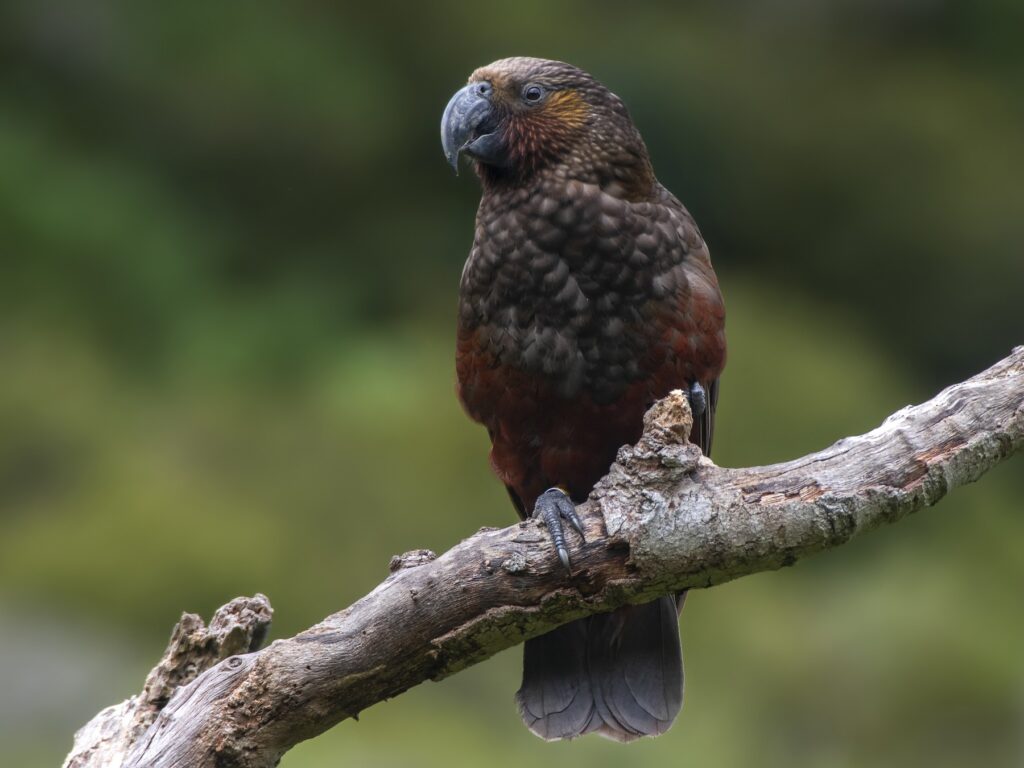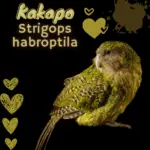
Nestor meridionalis Scientific name definitions
- EN Endangered
- Names (14)
- Subspecies (2)
New zealand parrot 45 cm; average 550 g. Forehead to nape whitish, lightly edged buff; face brown with broad pinkish flecks that become yellow on ear-coverts;
colors of head shade to olive-grey on the nape and dull rust-red, lightly scaled black, on the upper mantle, latter color extending onto the lower neck, flanks, belly, under tail-coverts, rump, and upper tail-coverts; throat and breast, lower mantle, upper back, and wings scaled brownish grey.
New zealand parrot Female has shorter and less curved bills. Immature similar to adult with pale eye-ring. Race septentrionalis duller, darker and smaller.
Systematics History
Editor’s Note: This article requires further editing work to merge existing content into the appropriate Subspecies sections. Please bear with us while this update takes place. Probably closest to †N. productus, formerly of Norfolk I and nearby Phillip I (became extinct in the mid-19th century). Two subspecies were recognized.
Subspecies
SUBSPECIES
Nestor meridionalis septentrionalis Scientific name definitions
N. m. septentrionalis
Distribution
North I and some offshore islands.
SUBSPECIES
Nestor meridionalis meridionalis Scientific name definitions
N. m. meridionalis+1
Distribution
South I, Stewart I and larger offshore islands.
Distribution
Editor’s Note: Additional distribution information for this taxon can be found in the ‘Subspecies’ article above. In the future we will develop a range-wide distribution article.
Habitat
Remaining areas of lowland and mid-altitude native forest.
Movement
New Zealand Kaka parrots are partly nomadic, sometimes appearing in areas from which they have been absent for some time. In winter birds appear to wander into more open country.
Diet and Foraging
Fruits, including Podocarpus ferrugineus, Beilschmiedia tarairi, berries, seeds (notably of Agathis australis), flowers, buds, nectar, and invertebrates.
The sap of Pseudopanax colensoi, Griselinia littoralis, Nothofagus solandri, Metrosideros umbellata and, on Stewart, I, Dacrydium cupressinum important in winter, along with winter-flowering puriri (Vitex lucens) and kohekohe (Dysoxylum spectabile).
new zealand parrots reintroduced in Wellington City take sap also from trees in parks, particularly exotic conifers as Cupressus macrocarpa, Chamaecyparis lawsoniana, and Cryptomeria japonica.
Honeydew from the scale insect Ultracoelostoma assimilate is critically important in the Nothofagus forest in summer and autumn, while larvae of the longhorn beetle Ochrocydus huttoni are protein-rich but expensive in energy to obtain. Recorded feeding in kiwifruit orchard, Sept, and on flax flowers, Jan.
Sounds and Vocal Behavior
The commonest new zealand parrot call, typically given in flight, is a very harsh grating “krraah” or “ka-rah” repeated at intervals. When perched, similar harsh calls are mixed with a variety of loud, musical yodeling whistles.
Breeding
Sept–Mar. new zealand parrot Nest in a large hollow in limb or trunk, also in the hollow base of cabbage tree; on Kapiti commonly below 3 m, and the preferred trees being Melicytus ramiflorus and Dysoxylum spectabile.
Clutch 1–8 (usually 3–5); eggs white, slightly oval, surface tending to be slightly rough, 41·5 mm × 31·5 mm on average (n = 12); incubation c. 3 weeks, only by the female;
hatching success varies from 39–66% between sites, but also between breeding seasons at each site, in part due to the level of control of introduced predatory mammals;
nestlings are covered in white down at hatching and develop a dense covering of grey down when 11–20 days old; nestling period c. 70 days; the proportion of eggs that produce fledglings varies from 19–53% between sites, depending on the level of control of predatory mammals. Young dependent on food provided by parents for 4–5 months.
Conservation Status
ENDANGERED. CITES II. Previously listed as Vulnerable. The species has suffered chronic decline owing to habitat clearance, and mainland populations face further declines owing to predation by introduced stoats and rats, competition for honeydew from introduced wasps and possums (which appears to have a disastrous impact on breeding performance), and continuing habitat clearance. Its numbers remain high only on offshore islands such as Little Barrier, Codfish and Kapiti.




















